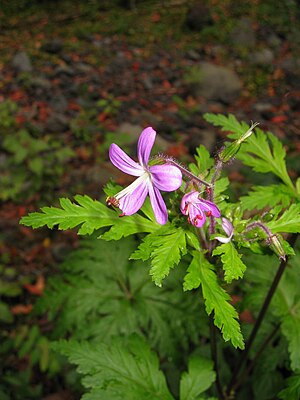Canary cranesbill
| Canary cranesbill | ||||||||||||
|---|---|---|---|---|---|---|---|---|---|---|---|---|

Canary cranesbill ( Geranium reuteri ) |
||||||||||||
| Systematics | ||||||||||||
|
||||||||||||
| Scientific name | ||||||||||||
| Geranium reuteri | ||||||||||||
| Aedo & Muñoz Garm. |
The geranium canariense ( Geranium reuteri , Syn. : Geranium canariense ) is a plant of the genus geranium ( Geranium ) and belongs to the family of geraniaceae (Geraniaceae).
description
The perennial herbaceous plant reaches heights of growth between 20 and 100 centimeters. The sturdy plant is sometimes a little woody at the bottom. The leaves are slightly hairy at most on the underside of the leaf veins . The leaf blades are five-lobed to the base with pinnate, notched-serrated sections.
The flowers are on strongly protruding hairy stems and are between 2 and 3 centimeters wide. The goblet is burned. The petals are pink, slightly whitish on the outside. The stamens are fused at the base. The stamens are pink, the anthers are red. Flowering time is from April to August. The fruit is a multi- seeded , somewhat fleshy capsule that contains black seeds .
Occurrence
The Canary Cranesbill only grows in the Canary Islands , with the exception of Lanzarote and Fuerteventura . The species prefers open areas in laurel forests .
Taxonomy
The first description of the species was in 1858 by George François Reuter as Geranium canariense . However, this name is a younger homonym of Geranium canariense ( Willd. ) Poir. , a recombination from 1812 with the basionym Pelargonium canariense . The latter name refers to Pelargonium candicans Spreng. , a species of pelargonium from South Africa that Carl Ludwig Willdenow mistakenly stated as occurring in the Canary Islands. Since the name Geranium canariense Reut. cannot be used as a younger homonym, the species was given a new name in 1997 in honor of the first descriptor.
literature
- Schönfelder: Kosmos Atlas Mediterranean and Canary Islands flora. Stuttgart 2002, ISBN 3-440-09361-1 .
- Hohenester / Welss: Excursion flora for the Canary Islands. Stuttgart 1993, ISBN 3-8001-3466-7 .
- Cabrera Pérez: The native flora of the Canary Islands. 1999, ISBN 84-241-3550-4 .
Individual evidence
- ↑ Poiret JLM 1812: Encyclopédie Méthodique. Botanique. Supplement, Tome II. H. Agasse, Paris. 876 pp . 752 - Online
- ↑ Pelargonium candicans Spreng. In: African Plants Database. Conservatoire et Jardin botaniques de la Ville de Genève & South African National Biodiversity Institute, Pretoria, accessed February 17, 2014 .
- ↑ Willdenow CL 1803-1806: Hortus Berolinensis. Tomus I. Berlin. - Text for Tab. XVII - Online
- ^ Aedo C., Muñoz Garmendia F. 1997: Twelve new names in Geranium L. (Geraniaceae). Kew Bulletin 52: 725-727. - Online at JSTOR